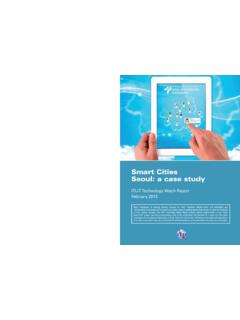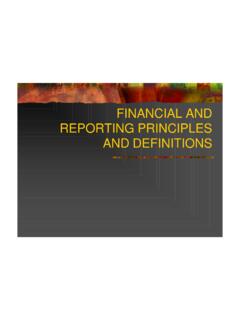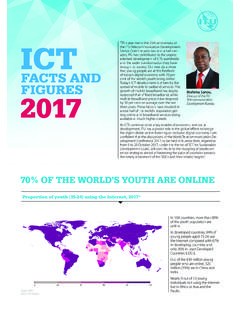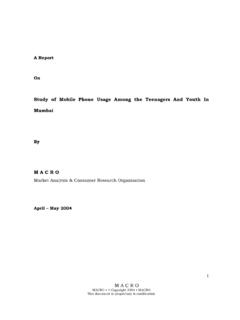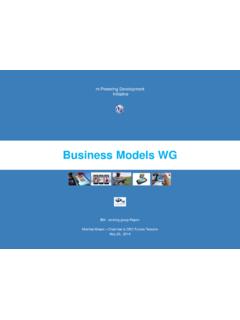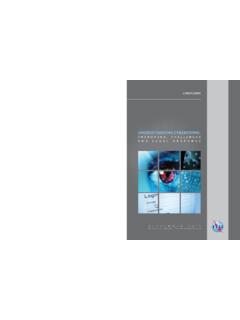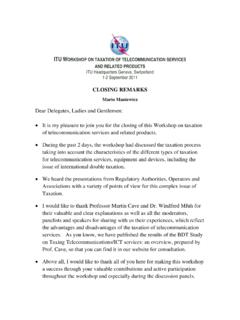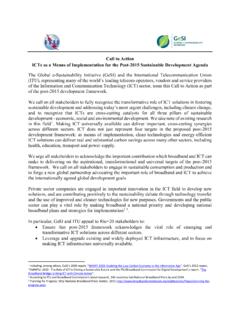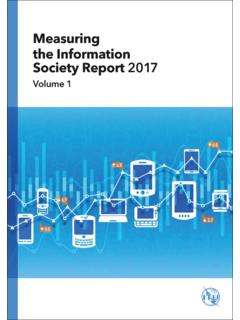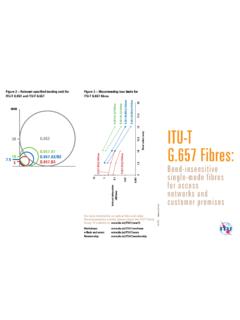Transcription of Handbook on Ground Wave Propagation - ITU
1 Handbook ON Ground WAVEPROPAGATIONI nternational Telecommunication UnionSales and Marketing DivisionPlace des NationsCH-1211 Geneva 20 SwitzerlandFax: +41 22 730 5194 Tel.: +41 22 730 6141E-mail: of 2014 Radiocommunication BureauHANDBOOK ON Ground WAVE Propagation Edition of 2014 Printed in SwitzerlandGeneva, 2014 Photo credit: ShutterstockISBN 978-92-61-14641-2 SAP id978926114641238980 Handbook on Ground Wave Propagation Edition of 2014 Radiocommunication Bureau Handbook on Ground Wave Propagation iii Introduction Ground wave Propagation is of special interest for communication, particularly broadcasting, at the lower frequencies where the mode has been in use for more than 90 years.
2 The Handbook is divided into four main parts dealing with: the fundamentals and theory; the main, wide scale considerations and prediction methods used for compatibility assessments and planning procedures, used for spectrum management and coverage purposes; the smaller scale variability which may be of major importance in assessing the quality of services; measurements and phase. Contributors to the Handbook , in alphabetical order, include: Itziar ANGULO Les BARCLAY Yuri CHERNOV Nick DEMINCO Igor FERN NDEZ Unai GIL David GUERRA John MILSOM Iv n PE A David DE LA VEGA. Handbook on Ground Wave Propagation v TABLE OF CONTENTS Page PART 1 - Theoretical considerations.
3 1 1 Introduction .. 1 2 The development of surface wave 1 3 Surface wave Theory .. 2 Introduction to the theory .. 2 Theory for a homogeneous smooth earth .. 4 The effect of the atmosphere .. 7 PART 2 - The ITU-R recommended prediction method .. 9 4 Recommendation ITU-R .. 9 5 Surface impedance .. 11 6 Ground conductivity .. 11 The conductivity of land .. 11 Sea conductivity .. 13 PART 3 - Variations from the main prediction procedure .. 15 7 Smooth earth of mixed conductivity .. 15 The over-sea recovery effect .. 15 The Millington method for mixed paths .. 17 Estimation of a representative conductivity value for mixed paths at MF band.
4 17 8 Sea roughness .. 18 9 Rural environments .. 19 10 Urban environments .. 19 The effect of the densely built up urban areas, to 20 km .. 19 11 Seasonal variations in surface wave Propagation .. 29 History .. 29 Day by day variations in surface wave Propagation .. 32 PART 4 .. 33 12 Receiving antennas .. 33 13 Characterization of field strength spatial variability .. 34 14 Irregular terrain .. 35 vi Handbook on Ground Wave Propagation Page 14 Irregular terrain .. 35 15 Local effects in built-up areas .. 37 Measurements into densely built up areas .. 37 Transmission frequency influence in urban environments .. 41 Large scale variation of the field strength.
5 41 16 Small scale field strength spatial variation .. 42 17 Indoor Propagation .. 43 PART 5 .. 47 18 Measurement methods .. 47 Field strength meter .. 47 Measurement of radiated power .. 47 The measurement of the effective Ground conductivity .. 48 19 Surface wave phase [71] .. 49 Introduction .. 49 Smooth homogeneous earth .. 49 Secondary phase perturbations .. 49 Non-homogeneous paths .. 49 Terrain irregularities .. 50 Meteorological effects .. 50 ANNEX 1 The Generalised Lee method .. 51 20 References .. 53 Part 1 1 PART 1 Theoretical considerations 1 Introduction At medium frequencies, during daylight hours, sky-wave signals propagating via the ionosphere are highly attenuated and the Ground wave, or more strictly the surface wave, is the Propagation mode which carries all signals which occupy the MF broadcasting band.
6 Surface waves also support the operations of LF broadcasting, VLF/LF communication and navigation systems, HF short-range communication and some classes of HF radar in these cases sky wave modes may also be present. The surface wave Propagation depends on currents which flow in the Ground . The existence of the atmosphere changes the Propagation characteristics but is not essential for the mode. Horizontally polarised surface waves are very heavily attenuated and have little or no practical worth. All the applications mentioned above utilise vertically polarised surface waves. Unlike ionospherically propagated signals, the surface wave suffers negligible dispersion so that, in principle, wideband signals can be transmitted when the surface wave alone is active.
7 Fading only occurs when there is some temporal variation in the Propagation path. Overland Ground waves are stable signals, in some cases with some seasonal variation, and there may be variations over small distances where there are structures or significant topographic features. Over-sea surface wave Propagation can be subject to slow fading due to changing tidal effects and attenuation due to sea roughness. Methods based on the theoretical considerations, which form the basis of Recommendation ITU-R , have proved over many years to provide a robust and rather simple way of predicting the coverage of, for example, MF and LF broadcasting systems. Methods for prediction in high-rise city areas remain incomplete.
8 Additional losses due to local obstructions, severe topography, etc. are important, particularly when assessing the overall quality of a received service. Using robust modulation methods, time and frequency spreading of surface wave, and of combined surface and skywave modes, it is unlikely to cause significant degradation. The first part of this Handbook introduces Ground wave theory and goes on to describe techniques and prediction procedures suitable for overall wide-scale coverage predictions for spectrum management, planning and design purposes. However, particularly for systems with digital modulation, small scale effects due to buildings, topography, etc.
9 , may affect performance and service quality. Finally some information is given on measurements and on the relative phase of the Ground wave. 2 The development of surface wave theory In 1909 Sommerfeld [1] obtained a solution for a vertical electric dipole on the plane interface between an insulator and a conductor. Sommerfeld s work was not in a practical form for application by engineers and there was also an error which led to some confusion. In 1936 Norton [2] largely overcame these problems, and a further paper in 1937 [3] provided a method for calculations over a flat earth. Van der Pol and Bremmer [4] in a set of papers in 1937 to 1939 made it possible to calculate field strengths at distant points on the spherical Earth s surface, using a residue series.
10 A further paper by Norton [5] in 1941 turned this into a more practical proposition for the engineer. These methods still did not allow for variation of the Earth s constants (permittivity and conductivity) along the path. This is particularly important when the path is a mixture of land and sea, where the conductivities differ by a factor of about a thousand. In 1949 Millington [6] introduced a semi-empirical method to give fairly accurate results for a path which included changes in the Earth s constants. In 1952, Hufford [7] published a paper which allowed for arbitrary changes of both the Earth s constants and shape along the path. This is in the form of an integral equation which is, for all practical purposes, impossible to solve manually.
